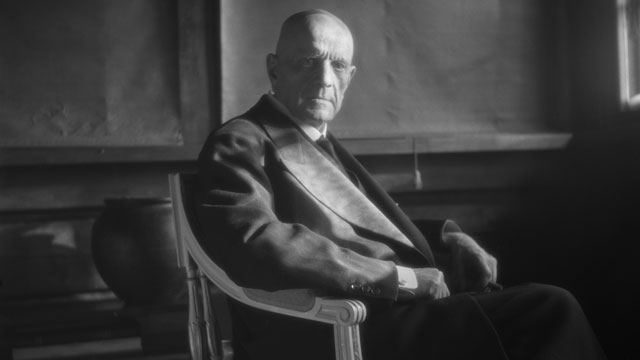Jean Sibelius, Winter, and Quebec by Éric Champagne
/ December 1, 2015
Version française...

Sibelius would have been 150 years old on December 8. To mark the anniversary, we asked our colleague, composer Éric Champagne, to tell us about the great Finnish master.
The first time I heard the music of Sibelius was during a cegep course in music literature that included Finlandia. I immediately loved the piece for its patriotic lyricism and triumphant finale. I didn’t know then that my emotions were going to be pushed even further: A few days later, I listened to a record that included both his first and his fifth symphonies, played by the New York Philharmonic and conducted by the fiery Leonard Bernstein. The first symphony had the epic feel of Finlandia, but on a larger scale. I was on familiar ground. But then came the fifth, and what a revelation: Here was some truly sublime music!
This symphony is a veritable journey across the land: The first movement begins in open countryside, breathing great lungfuls of fresh air. Then, in a spectacular sonic blend worthy of the greatest electroacoustic music, it turns into a rush of sparkling energy. The second movement is imbued with incomparable tenderness and delicacy, with a tinge of melancholy typical of Nordic art. The last movement, unique of its kind in the symphonic repertoire, is famous for its theme of tolling chords, obsessive and hypnotic. This yields to colourful melodies and sublime orchestral tremolos, to conclude on an aching tension, the theme infinitely transfigured. I sat there open-mouthed, unable to move, listening to the last chords between magical, dizzy silences. It was completely disarming, like the view into space from a cliff. Music like this draws you out of yourself, beyond the monotony of the world.
Just then an odd thought occurred to me: Sibelius could have been a Quebecer! He’s so obviously one of us! He has the eye and the ear to celebrate our magnificent landscapes and our redoubtable winters. Listening to his music, I see vast open spaces covered in immaculate, shining snow. In the most tortuous passages of his subtly innovative harmonies, I feel the biting cold wind. In his majestic melodies I see the blinding January sun, splendid and violent. His orchestral colours spring to life in the pure, cold air. Yes, I really think Sibelius was a Quebecer!
Something else came to support my theory when I discovered the music of Canadian composer Michel Longtin, soulmate of the Finn, sharing his opulent treatment of the symphonic language, poet of the tragic beauty of nature and humanity. Longtin elevates nature with a bit more acidity but just as much splendour and wonder, and both composers draw from it with equal success. Longtin quite openly says that Sibelius was for him a master and an inspiration. Pohjatuuli is a magical and deeply personal tribute to the sonic world of Sibelius, just as Autour d’Ainola is an epic painting from a poetic, near-legendary imagination. Beyond the thematic relationship, I like to think that Sibelius and Longtin are soul-brothers, cultivating the same ideal, pursuing the same quest. I see the same roots in their music, namely the wild beauty of large open spaces, the magnificence and nobility of nature; the melancholy and meditative admiration of the landscape and the tragic smallness of human destiny. Longtin and Sibelius transcend all this by creating a sonic world that is grandiose, disconcerting, magical, almost mystical.
One day, however, I hit a wall. I found out that Sibelius noted in his diary that he had seen some swans circling over the lake near Ainola, his house. This was the inspiration for the symphony, and it occurred on April 21st. I was deeply disappointed! How could spring have produced this obviously wintry music? How could flying swans take the place of a snowstorm? And then I understood that music is the most abstract of the arts, doesn’t contain just one truth, and can be perceived in different ways. Yet regardless of circumstantial detail, what appealed to Sibelius were the primal forces of nature—powers that transcend his music: What cannot be felt or spoken reaches our hearts just the same.
Now in harmony with my perception of the music, I’ve created a special tradition for myself: When a snowstorm is brewing, I turn my armchair to the window, curl up with a woollen blanket and a mug of hot chocolate, and listen to the Fifth Symphony. I watch and let my thoughts drift with the snowflakes and the wind. Every time, the sight enchants me. I like to think that Sibelius and we whose “country is not a country, it’s winter”, share this capacity for wonder at the power of nature. And every time I am moved, almost to tears, by such beauty.
Translation: Cecilia Grayson
Version française... | |

